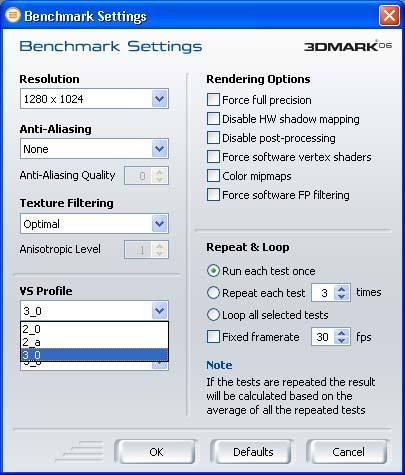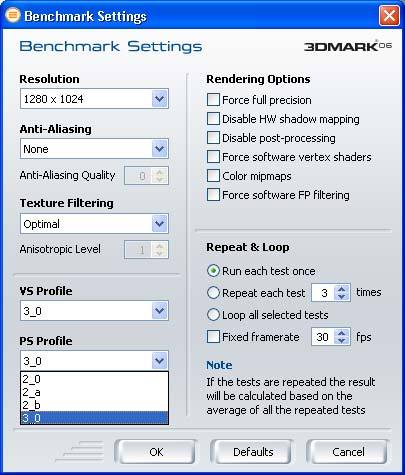3DMark06 Under the Magnifying Glass
The "Revised" Engine... 3DMark06
The Filtering and AA tool returns.
All of the preceding history leads us to 3DMark06. Futuremark took the existing engine from 3DMark05 and added Shader Model 3.0 content and other DirectX9 features. This includes items such as 16-bit floating point textures and 16-bit floating point blending. This hardware feature is mentioned in the DirectX API. Note that this is available on Nvidia hardware, while ATI chooses to render this in shader programs rather than a direct hardware path.
Another buzzword in gaming has been HDR rendering. We will discuss this later on, but Futuremark made this a "key element of the new engine" and it can be seen in both of the SM 3.0 tests.
Here you can change the level at which you want the vertex shader to run.
The engine in 3DMark06 is similar to that used in 3DMark05, as it again used HLSL format to build its shaders. Again, it is "compiled to best fit the installed hardware, or the user may manually set which compilation profile to use." This time, the whitepaper for 3DMark06 clarifies that a "reviewer can compare the performance difference using different shader compiler profiles for the same hardware."
Here you can change the level at which you want the pixel shader to run.
3DMark06 moved away from Perspective Shadow Maps in order to accommodate another depth shadow mapping type called Cascaded Shadow Maps (CSM). This implementation permits dynamic shadows for all screen objects that are angle independent. Futuremark divides the view frustum (the view area available in your current camera view) into five sections along the z-axis. In short, this means this technique can draw shadows for all of the objects, regardless of their angles. The CSM technique uses 2048x2048 shadowmaps. If the hardware supports depth textures, a D24X8 (A 32-bit z-buffer bit depth that uses 24 bits for the depth channel) or DF24 depth map is used, otherwise a R32F single component 32-bit floating point texture will be used for a depth map.
Get Tom's Hardware's best news and in-depth reviews, straight to your inbox.
Current page: The "Revised" Engine... 3DMark06
Prev Page The "Revised" Engine Next Page Shadow Rendering And High Dynamic Range

